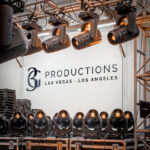It was an era where people like him were either cops, priests, criminals or stagehands,” says Rich Wolpert, referring to his grandfather, Bill Wolpert, founder of Union Connector. Given those choices, Bill could have done worse. But instead of turning to a life of crime – or arresting or hearing confessions from others who had – Bill Wolpert worked as a union stagehand on Broadway.
Bill Wolpert also moonlighted for a stage pin connector manufacturer, started making his own stage pin connectors on the side, and launched a three-generation family business that now also makes power distribution, emergency transfer systems, cases, and specialty lighting and touring accessories.
A Family Business
If it has grown in size as well as product range, Union Connector remains a family business. It got started by Bill Wolpert, was continued by Bill’s son, Dick Wolpert, and expanded further under the leadership of Dick’s two sons, Ray Wolpert, who remains at the company’s home base in West Babylon, N.Y., and Rich Wolpert, who grew up with the family business on Long Island but transplanted to, of all places, the Ozark Mountains of Missouri. There, in Springfield, Mo., from Union Connector’s “Midwest Development Office,” Rich Wolpert details the history of the company.
“It’s a family business,” Wolpert says, with a noticeable sense of pride, detailing how his grandfather, while still working as a stagehand, moonlighted for the Kleigl brothers. “As he was making connectors for Kleigl he thought, ‘Hey, I could do that.'” So Union Connector was founded – in the unluckiest of years, 1929.
Bill Wolpert kept working all three jobs – as a stagehand, for Kleigl, and on his own – until one day one of Kleigl’s shop foremen said the Kleigl brothers knew that someone who was working for them was also building competing products. “When they find out who it is,” Rich recounts, “he’s gonna get his legs broken.” Bill Wolpert wisely took this as a sign to tender his resignation. (Rich adds that while his grandfather and the Kleigl brothers never talked after that, those in the next generation of both companies were friendly and even did business together.)
While keeping Union Connector on the side, Bill Wolpert continued his lucrative work as a stagehand. “He was property master at the Plymouth Theater, and he was making relatively good money for the 1950s,” Rich Wolpert notes, adding that, despite only having an eighth grade education, he was able to afford a nice house in an exclusive neighborhood filled with doctors and lawyers. He was also able to dress in a dapperly fashion.
“Everyone else was coming home from work in the late afternoon, and my grandfather, dressed sharp like a Duke, would just be leaving to go into the city,” Rich says. “They thought he was in the mob!”
Bill Wolpert’s son, Dick, began working for Union Connector when he was a kid, and after a stint in the Navy during World War II he got his Local 1 union card. Dick then went to college on the G.I. Bill and would earn degrees in biology and education, then a Masters degrees from Columbia University. He worked as a pharmaceutical salesman, stayed active as a stagehand and member of IATSE Local 1 and eventually came home to Long Island to work in the family business. At the time, the company was still a part-time affair, making mostly connectors. “But we made them for everybody,” Rich says, adding that under the management of Dick, his father, the business started to really grow.
During its first four decades, Union Connector built its reputation on the simple stage pin connector – introducing, during that time, the grounding version of the device. Union Connector was also the first to mold the connector out of thermoset plastic. By the 1970s, the expansion of the company was in full force. The Wolperts moved to a larger facility and began building power distribution equipment for the theatrical lighting industry.
As that industry grew and expanded into touring, architectural, and event lighting, Union Connector’s product line expanded with outlet boxes, connector strips, patch panels and more. In the 1980s, the company hired Steve Skirpan, who has been called the father of digital dimming, as a consultant. He contributed much to the growth of the company.
“Because of him, we were able to create a great deal of new products,” Rich Wolpert says. “We came up with UL versions of a company switch, and the first emergency branch circuit transfer system. We were able to offer the Polybox Portable Power Distribution Box – about which we were told it was too expensive, too heavy, etc. And about five years later, half a dozen companies were doing the same thing. That made me think that maybe we’re not as stupid as we think we are!”
By the 1990s, Union Connector continued to expand its product line and moved to an even-larger manufacturing center. More patents were awarded, and another product developed in the 1990s was the UC700 Emergency Transfer System. It is the first branch circuit transfer system designed specifically for use with dimming systems.
The Fun Stuff
As a teen, Rich Wolpert also worked in the shop, but he was not enthused. “It was noisy, you wore earplugs and glasses, you dealt with asbestos wiring, and you came home dirty. Being a typical teen, I butted heads with my dad a lot. When I was 17, I graduated from high school, and thought, ‘There’s no way in hell I’m doing this!'”
Like his dad, he got a degree in education, and then he had a variety of careers over the next decade, from teaching high school science to working for an oil company. As he grew older, he came to appreciate the family business, and even though he moved to the Ozark mountains of Missouri in 1974, he would express an interest in working for Union in 1983. His father played his hand coyly, mumbling that he might be able to find a place for him. Rich would later learn from his mother that his dad was absolutely ecstatic about him joining the business. Their relationship flourished and they became good friends.
Rich’s brother Ray, fifteen years his junior, joined the company in 1994 after getting his degree in Industrial Engineering from Rochester Institute of Technology and spending a couple of years on the shop floor at a Ford factory in Buffalo. “Ray always wanted to work at Union, and he’s been the one to drag our shop, kicking and screaming, into the 21st century. He had a tough time convincing me to spend money on CNC machines, but it literally saved us with his industrial experience and engineering know-how,” says Rich, proudly of his brother. “He’s the Big Kahuna in the company now.
“My job is a whole lot easier than Ray’s. I joke that I take people out to dinner for a living,” Rich Wolpert laughs. But what he really does for Union Connector is to work closely with consultants and engineers to come up with solutions to a wide variety of situations. Major investments have been made in CNC fabrication machinery, computerized warehouse facilities and engineering facilities. Power distribution equipment for entertainment lighting is still the bulk of the company’s product line, much of it custom-designed and built for specific projects.
“Rigging and staging companies come to us in a pinch to fix problems, and sometimes its oddball stuff. I’ll have an architect come up to me and say, ‘I saw this on stage, can you make it for my office?’ To me that’s the fun stuff,” Wolpert says.
Today, along with that custom work, Union Connector offers an array of products including connectors, power distribution, emergency transfer systems, cases and specialty lighting and touring accessories. One of their latest products is the SafeCam outlet system, which senses when plugs are inserted and automatically disconnects the power to the outlets until all the cam outlets have plugs inserted. This prevents the unsuspecting worker – or wayward child – from contacting an energized exposed outlet.
The SafeCam outlet system isn’t the only example of how Union Connector puts a premium of safety, however. When asked to do something that they don’t feel they can do 100 percent safely, they have no problem walking away from the project. “We view it as a moral responsibility – even when we’re assured only highly trained professionals are going to use it, we don’t want to take a chance on creating something that could possibly hurt someone down the road, no matter what the money is.”
Today, Union Connector continues to build upon its humble beginnings. “We went from just being a connector company to being what I think of as a problem solving company,” Rich Wolpert says. “We make products that solve people’s problems.”


